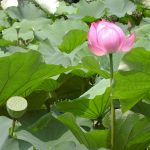| Common Name: |
Padma |
| Other Names: |
Sacred Lotus |
| Botanical Name: |
Nelumbo nucifera syn. Nelumbium speciosum |
| Genus: |
Nelumbo |
| Family: |
Nelumbonaceae |
| Native Location: |
Asia, from Iran to Japan, and N. Australia |
| Cultivation: |
Sunny position in rich, heavy soil in still or slow-moving water at least 60cm (24in) deep, or in large pots of rich, wet soil mix under cover. May be invasive in good conditions outdoors. |
| Propagation: |
By seed sown at 25°C (77°C) covered by 5cm (2in) of water, or by division in spring. |
| Harvest: |
Leaves and leaf stalks are collected in summer and autumn; rhizomes in autumn and winter; stamen from early to mid-summer; seeds and flower stalks with receptacles from mid- to late summer. All parts are dried for use in decoctions and powders. (Plumule and radicle are separated from seeds before drying). |
| Height: |
2.5m (8ft) above water |
| Width: |
Indefinite; less in cultivation. |
| Variations: |
Alba Grandiflora
Has pure white flowers, 22-25cm (9-10in) across.
Height: 1.2-1.8m (4-6ft)
Width: 60-90cm (24-36in) |
Charles Thomas
Has deep lavender-pink flowers. 15-20cm (6-8in) across.
Height: 60-90cm (2-3ft) |
Momo Botan
Has deep pink flowers, 15cm (6in) across, shading to yellow in the center.
Height: 60cm-1.2m (2-4ft) |
Rosea Plena
Has double pink flowers, 25-35cm (10-14in) across.
Height: 1.2-1.5m (4-5ft) |
|
| Hardiness: |
Z5-10 |
| Parts Used: |
Leaves (he ye), stems, i.e. leaf stalk (lian geng), or flower stalk with receptacle attached (lian fang), rhizomes (ou jie), flower stamens (lian xu), seed plumule and radicle (lian zi xin), seeds (lian zi). |
| Properties: |
An astringent, cooling herb that controls bleeding, lowers blood pressure and fever, sedates the heart energy, and acts as a tonic for the spleen and kidney energies. |
| Medicinal Uses: |
Internally for hemorrhage, nosebleed, heavy menstruation (rhizome); hypertension, insomnia, restlessness (plumule and radicle); diarrhea, poor digestion, insomnia, palpitations (seeds); urinary frequency, premature ejaculation (stamens); bleeding gastric ulcer, heavy menstruation, postpartum hemorrhage (flower stalk). In Ayurvedic medicine, mainly as cooling remedies for bleeding disorders, and tonics for the heart and reproductive centers (rhizomes and seeds). |
| Culinary Uses: |
Rhizomes are cooked as vegetables, pickled, or conserved; also a source of edible starch. Seeds are eaten raw, roasted, pickled, candied, puffed (makhana), or used as a garnish. Young leaves are eaten raw or lightly stir-fried. Dried whole leaves are used as a wrapping for dim sum and other foods. Stamens and pollen are used to scent tea. |
| Bibliography: |
Encyclopedia of Herbs by Deni Brown Copyright © 1995, 2001 Dorling Kindersley Limited Pp 287-288 |

